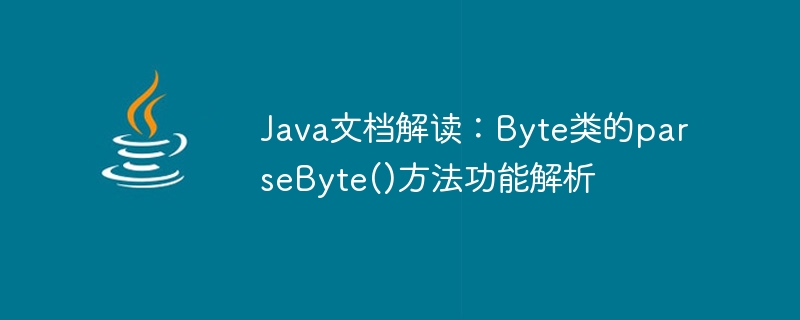

Interpretation of Java documentation: functional analysis of the parseByte() method of the Byte class, specific code examples are required
Introduction:
Java is an object-oriented programming language , providing a rich class library and methods to meet the needs of developers. During the development process, we often encounter situations where we need to convert strings into byte types. The parseByte() method of the Byte class is used to implement such a function. This article will deeply analyze the functions of the parseByte() method of the Byte class and give specific code examples.
1. Introduction to the parseByte() method of the Byte class
The Byte class is a wrapper class in the Java language, which encapsulates the basic data type byte. The parseByte() method of the Byte class is a static method used to parse string parameters into byte type values. The signature of this method is as follows:
public static byte parseByte(String s) throws NumberFormatException
2. Function analysis of the parseByte() method of the Byte class
Parsing of string
The parseByte() method parses the string parameter into a byte value. The string must represent a legal byte value, ranging from -128 to 127. If the string parameter is not a legal byte value, a NumberFormatException will be thrown.
The parseByte() method ignores leading and trailing spaces in the string parameter. The characters in the string parameter should be decimal numeric characters, optionally preceded by a minus sign to indicate negative numbers.
public class ByteParseExample {
public static void main(String[] args) {
String str = "123";
byte b = Byte.parseByte(str);
System.out.println("转换后的字节值为:" + b);
}
}In the above code, a string type is first defined The variable str, the value of this variable is "123". Then use the parseByte() method of the Byte class to convert the string into a byte type value, and assign the result to the variable b. Finally, call the System.out.println() method to print out the converted byte value.
3. Summary
The parseByte() method of the Byte class is a static method used to parse string parameters into byte type values. This method parses the string into a byte value, ranging from -128 to 127. If the string cannot be parsed into a legal byte value, a NumberFormatException will be thrown.
When using the parseByte() method of the Byte class, you need to note that the string parameter passed in must be legal and within the range. When using this method, you can catch and handle NumberFormatException exceptions through the exception handling mechanism.
The above is an analysis of the function of the parseByte() method of the Byte class, as well as the corresponding code examples. By understanding the usage and precautions of this method, we can better utilize this feature in actual development and improve the readability and maintainability of the code.
The above is the detailed content of Interpretation of Java documentation: Function analysis of parseByte() method of Byte class. For more information, please follow other related articles on the PHP Chinese website!




